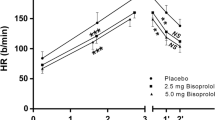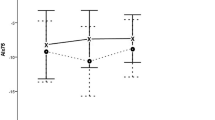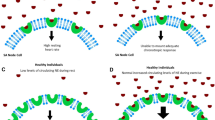Summary
Patients receiving β-receptor antagonists for the treatment of hypertension frequently complain of impaired exercise tolerance. To determine whether these medications impair skeletal muscle contractile function, we measured isokinetic muscle function in ten healthy male cyclists receiving nebivolol (N), atenolol (A), propranolol (P) and the calcium channel antagonist diltiazem (D). The subjects performed standardized tests of muscle power on an isokinetic cycle ergometer following subacute ingestion of N, A, P, D and placebo (PL) in a double blind crossover trial. Subjects exercised maximally for 10 s at 90, 110, 120, 130 and 150 rpm with 2-min rest between sessions. Thereafter, they performed a 30-s fatigue test at 120 rpm. Resting heart rate was decreased 13.4%, 21.9% and 14.6% by N, A and P, respectively (P<0.05 vs PL). Resting systolic blood pressure was decreased 6.7% by A only (P < 0.05 vs PL). Peak power, average power and work done was not different among treatment groups at any crank velocity, nor was there any difference in total work done or rate of work decline in the 30-s test. We concluded from our study that peak isokinetic muscle power during maximal exercise of short duration is not affected by β-blockade or the calcium antagonist diltiazem. Fatigue during β-receptor antagonism would not appear therefore to be due to changes in the ability of skeletal muscle to produce peak power output during exercise of short duration.
Similar content being viewed by others
References
Aigner A, Muss N, Krempler F, Fenninger H, Sandhofer F (1983) Einflufß einer akuten β1- und β1/β2-Rezeptorenblok-kade auf den Kohle-Hydrat- und Fettstoffwechsel unter Belastungsbedingungen. D Med Wochenschr 108:293–298
Alway SE, Hughson RL, Green HJ, Patla AE, Frank JS (1987) Contractile properties of the triceps surae following prolonged exercise and β-blockade. Clin Physiol 7:151–163
Alway SE, Hughson RL, Green HJ, Patla AE (1988) Human tibialis anterior contractile responses following fatiguing exercise with and without β-adrenoceptor blockade. Clin Physiol 8:215–225
Bowman WC, Nott MW (1969) Actions of sympathomimetic and their antagonists on skeletal muscle. Pharmacol Rev 21:27–72
Collomp K, Ahmaidi S, Audran M, Chanal JL, Préfaut Ch (1991) Effects of caffeine ingestion on performance and anaerobic metabolism during the Wingate test. Int J Sports Med 12:439–443
Derman EW, Hans M, Dunbar F, Noakes TD (1991) Cardiovascular, respiratory and metabolic effects of nebivolol during maximal and submaximal exercise performance. J Drug Invest 3 [Suppl 1]:33–39
Glanz SA (1980) Biostatistics: how to detect, correct and prevent errors in the medical literature. Circulation 61:1–7
Grimby G, Smith U (1978)β-blockade and muscle function (letter). Lancet 11:1318–1319
Hughson RL, Green HJ, Alway SE, Patla AE, Frank JS (1987) The effects of β-blockade on electrically stimulated contraction in fatigued human triceps surae muscle. Clin Physiol 7:133–150
Jilka SM, Joyner MJ, Nittolo JM, Kalis JK, Taylor JA, Lohman TG, Wilmore JH (1988) Maximal exercise responses to acute and chronic β-adrenergic blockade in healthy male subjects. Med Sci Sports Exerc 20:570–573
Joyner MJ, Freund BJ, Jilka SM, Hetrick GA, Martinez E, Ewy GA, Wilmore JH (1986) Effects of β-blockade on exercise capacity of trained and untrained men: a hemodynamic comparison. J Appl Physiol 60:1429–1434
Kaiser P (1984) Physical performance and muscle metabolism during β-adrenergic blockade in man. Acta Physiol Scand [Suppl] 563:1–53
Karlsson J, Kjessel, T, Kaiser P (1983) Alpine skiing and acute β-blockade. Int J Sports Med 4:190–193
Lawlor MR, Thomas DP, Michele JJ, Carey RA, Paolone AM, Bove AA (1985) Effects of chronic β-adrenergic blockade on haemodynamic and metabolic responses to endurance training. Med Sci Sports Exerc 17:393–400
Lewis RV, Jackson PR, Ramsay LE (1984) Quantification of side-effects of β-adrenoceptor blockers using visual analogue scales. Br J Pharmacol 18:325–330
McCartney N, Heigenhauser GJF, Sergeant AJ, Jones NJ (1983a) A constant velocity cycle ergometer for the study of dynamic muscle function. J Appl Physiol 55:212–217
McCartney N, Heigenhauser GJF, Jones NL (1983b) Power output and fatigue of human muscle in maximal cycling exercise. J Appl Physiol 55:218–224
McCartney N, Oldridge NB, Hicks A (1989) Maximal isokinetic cycle ergometry in patients with coronary artery disease. Med Sci Sports Exerc 21:313–318
Noakes TD (1988) Implications of exercise testing for prediction of athletic performance: a contemporary perspective. Med Sci Sports Exerc 20:319–330
Noakes TD, Myburgh KH, Schall R (1990) Peak treadmill running velocity during the VO2max test predicts running performance. J Sport Sci 8:35–45
Rusko H, Kantola H, Luhtanen P, Pulli M, Videman T, Viitasalo JT (1980) Effect of β-blockade on performances requiring, force, velocity, coordination and/or aerobic metabolism. J Sports Med 20:139–144
Sable DL, Brammell HL, Sheehan MW, Nies AS, Gerber J, Horowitz LD (1982) Attenuation of exercise conditioning by β-adrenergic blockade. Circulation 65:679–684
Sanchez RA, Cianciulli T, Dopico AM, Gianonne C, Altamirano J, Ramirez AJ, Marco EJ (1991) Effects of nebivolol on left ventricular function in patients with essential hypertension. Drug Invest 3 [Suppl 1]:155–160
Stephen SA (1966) Unwanted effects of propranolol. Am J Cardiol 18:463–472
Van Baak MA, Koene FMM, Verstappen FTJ (1988) Exercise haemodynamics and maximal exercise capacity during β-adre-noceptor blockade in normotensive and hypertensive subjects. Br J Clin Pharmacol 25:169–178
Vandewalle H, Peres G, Monod H (1987) Standard anaerobic exercise tests. Sports Med 4:268–289
Wilcox RG, Bennett T, Macdonald IA, Herbert M, Skene AM (1984) The effects of acute or chronic ingestion of propranolol or metopholol on the physiological response to prolonged submaximal exercise in hypertensive men. Br J Clin Pharmac 17:273–281
Yorko J, Kendrick ZV, Kimura IF, Van Oort G, Paran E, Hare TW, Lowenthal DT (1990) Effect of β-blockade on strength performance. Ann Sports Med 5:176–180
Author information
Authors and Affiliations
Rights and permissions
About this article
Cite this article
Derman, W.E., Dunbar, F., Haus, M. et al. Chronic β-blockade does not influence muscle power output during high-intensity exercise of short-duration. Europ. J. Appl. Physiol. 67, 415–419 (1993). https://doi.org/10.1007/BF00376457
Accepted:
Issue Date:
DOI: https://doi.org/10.1007/BF00376457




